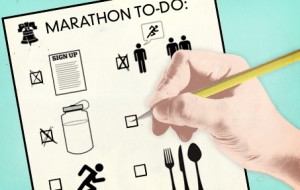Your Guide to Running (and Loving!) the Philadelphia Marathon
Running the Philadelphia Marathon or Half Marathon? Awesome! Now do a little planning to make sure you cross the finish line happy, healthy, and exited to run again. You want to do everything you can to make training for the race fun, while eliminating any excuses that would keep you from training.
Register for the race! Officially signing up puts you under some pressure and can help motivate you to start training. Plus, the Philly marathon and half will fill up, probably by the end of August. So if you haven’t registered yet, register here, and do it soon.
Tell your friends: This serves two purposes. You won’t want to back out of it if everyone thinks you are going to run, and you might find a friend who wants to join you.
Plan your training: To get your body ready to run 13.1 or 26.2 miles you want a plan that will gradually increase the distance you can run. You don’t have to come up with your own plan; coaches have been studying this for years and have developed some great plans already. You can join me at Team Philly Race Training, find a personal coach like those at runmammoth.com, or a free plan at halhigdon.com.
Good plans will have a few things in common: at least three short runs per week, recover days and cross-training days, and one long run per week. The most important run in training for a half or full marathon is your long run. Half marathoners should try to get up to 11 miles before the big day, while marathoners should expect to do a 20-miler. To get the benefit of these runs you will need to recover from them with shorter easy runs or cross training to get your blood flowing. Experienced runners can add in a midweek long run or a faster run.
Cross train: Runners used to view cross training as a last resort when injured, but it should be an important part of your running training. Focusing on exercises that strengthen your core should be a priority (think lunges, squats, crunches, planks, and anything on a stability ball). Strengthening your core can improve form, increase efficiency, and prevent injury.
Get fitted: Go to a running specialty store and let them know what race you are training for. They’ll help you find the shoes and gear to make your runs more comfortable and enjoyable. You want to cut down on excuses, so get the right shoes and ditch the cotton socks and clothes. Long runs are tough enough without a chafing sports bra, soggy feet, and shin splints!
Run the course (in pieces): The few hills that are on the Philly course are pretty small, but in the race they can seem like mountains. Run them ahead of time and you won’t be afraid of them. The first noticeable hill in the Philly course comes just before nine miles. If you normally run along Kelly Drive, head to the MLK (West River) side and turn at the first light (Sweet Briar) and then turn right at the stop sign (Lansdowne Drive). You are now on the course and heading up toward Memorial hall, one of the coolest places in Philly to run.
The second hill comes at the 14-mile mark in the marathon. After passing the Art Museum and heading onto Kelly Drive, you take a slight detour at the light in front of Lloyd Hall, making a right onto Poplar Drive. Take the first gradual left onto Sedgley Drive, come to the top of the hill and make your next left down Lemon Hill and back onto Kelly Drive.
The last significant hill comes just before the finish, as you head up from Kelly Drive to the Parkway. Count on crowds and adrenaline to push you through this last challenge.
Hydrate: Before, during, and after your runs. They hand out Gatorade on the course, so it is a good idea to drink some on your long runs to get your stomach used to it.
Eat: For many this is best part of running a long race! For a marathon or half marathon, you want to practice eating what you plan to have the morning of your race, as well as the day and night before. You can practice this before your longer runs to find out what works best for you.
To maintain your weight while training, you will want to add around 100 calories per mile you run (less for smaller runners, more for bigger runners). A 28-mile week will add about 400 calories per day (2,800 calories divided by 7 days equals 400 calories). Adding these calories early in the day (at breakfast and lunch) can help you maintain energy for your workouts and daily life.
A high carbohydrate diet is recommended by most nutritionists, shooting for somewhere in the 55-65% carbs, 25-30% fats and 10-15% protein range.
Be smart about carbs: Many runners will carbo load for a half marathon or marathon, but be careful! Typically you will be running less during the last week of training (and burning fewer calories), so simply eating the same amount will help load your muscles without adding any food. Marathoners should look to eat slightly bigger meals the two days before the event. Don’t look to overdo it in one ‘pasta party’ meal. Instead, eat a substantial breakfast and lunch, and don’t risk stomach drama with a huge dinner.
Race day should follow what you do for your long run days. Practice eating a 300-500 calorie high carb breakfast a few hours before you run. Marathoners should look to consume another 300-500 calories during the race. This can come from the sports drink on the course, energy gels, or gummy bears. My preference is for the easy-to-carry gels, taking the caffeinated ones later in the race.
Occasionally, on those super-long runs, you can even practice eating what you will eat after the race!



